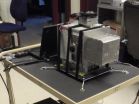(Press-News.org) ANN ARBOR, Mich.---A table-top gamma-ray detector created at the University of Michigan can not only identify the presence of dangerous nuclear materials, but can pinpoint and show their exact location and type, unlike conventional detectors.
"Other gamma ray detectors can tell you perhaps that nuclear materials are near a building, but with our detector, you can know the materials are in room A, or room B, for example," said Zhong He, a professor in the Department of Nuclear Engineering and Radiological Sciences.
"This is the first instrument for this purpose that can give you a real-time image of the radiation source. Not only can we tell you what material is there, but we can tell you where it is, and you can find it and walk towards it."
He presented this device, called Polaris, this week at the International Workshop on Room-Temperature Semiconductor Detectors, held in conjunction with 2010 IEEE Nuclear Science Symposium and Medical Imaging Conference in Knoxville, Tenn.
Gamma rays are high-energy photons, or particles of light. They are emitted by dirty bombs and special nuclear materials that could be used for nuclear weapons.
Polaris is composed of 18 cubes of the semiconductor cadmium zinc telluride. Each cube measures and records the energy and three-dimensional position of every gamma ray photon interaction that takes place within the detector. It also determines the direction each photon came from.
A computer connected to the detector uses the energy information to identify the type of material emitting it. Different materials appear in the detector's image as different colors. The device uses the photon direction and position information to show the location of the source.
He underscored why having an image to guide an inspector to a radiation source is especially helpful.
"If you don't have an image, it's like collecting the spectrum of the light in this room," he said. "You wouldn't know what's happening in the room. With an image, obviously, you can see what's happening, and who is here and where they are standing."
Polaris will also be more convenient and portable to use in the field, compared with its current counterparts, He said. It operates at room temperature, whereas the high-purity germanium gamma ray detectors typically used today must be cooled to -200 degrees Celsius or they won't work.
This research was funded by the Department of Defense's Defense Threat Reduction Agency, the Department of Energy, and the Domestic Nuclear Detection Office of the Department of Homeland Security.
The university is pursuing patent protection for the intellectual property, and is seeking commercialization partners to help bring the technology to market.
INFORMATION:
For more information:
Zhong He: http://czt-lab.engin.umich.edu/index_files/Page920.htm
Nuclear materials detector shows exact location of radiation sources
2010-11-05
ELSE PRESS RELEASES FROM THIS DATE:
Safe schools policy for LGBTQ students
2010-11-05
Youth who identify as lesbian, gay, bisexual, transgender, queer and/or questioning (LGBTQ) are vulnerable to bullying, harassment, compromised achievement, and emotional and behavioral health problems. A national survey of LGBTQ youth in secondary schools found that nearly all of them heard homophobic remarks in school, and three-quarters heard such remarks often. Moreover, 40 percent had been physically harassed and 20 percent had been physically assaulted.
A new Social Policy Report from SRCD on Safe Schools Policy for LGBTQ Students provides an overview of the research ...
Insufficient vitamin D levels in CLL patients linked to cancer progression and death
2010-11-05
ROCHESTER, Minn. -- Researchers at Mayo Clinic (http://www.mayoclinic.org/) have found a significant difference in cancer progression and death in chronic lymphocytic leukemia (CLL) patients who had sufficient vitamin D (http://www.mayoclinic.com/health/vitamin-d/NS_patient-vitamind) levels in their blood compared to those who didn't.
VIDEO ALERT: Additional audio and video resources, including excerpts from an interview with Dr. Tait Shanafelt, are available on the Mayo Clinic News Blog (http://newsblog.mayoclinic.org/2010/11/03/mayo-clinic-finds-insufficient-vitamin-d-levels-in-cll-patients-linked-to-cancer-progression-and-death/).
In ...
Scripps research scientists find nerve cell activity drains stem cell pool in developing brain
2010-11-05
LA JOLLA, CA, November 3, 2010 – For Immediate Release – As babies grow, their brain cells develop from a pool of stem cells—some stem cells continuously divide, replenishing the pool, whereas others morph into mature functioning nerve cells. Now researchers at The Scripps Research Institute have shown that as the newly formed nerve cells start firing electrical signals, this activity slows down stem cell division, emptying out the stem cell pool in favor of nerve cell formation.
The study, published in the November 4 issue of the journal Neuron, shows that brain activity ...
New 3-D model of RNA 'core domain' of enzyme telomerase may offer clues to cancer, aging
2010-11-05
Telomerase is an enzyme that maintains the DNA at the ends of our chromosomes, known as telomeres. In the absence of telomerase activity, every time our cells divide, our telomeres get shorter. This is part of the natural aging process, as most cells in the human body do not have much active telomerase. Eventually, these DNA-containing telomeres, which act as protective caps at the ends of chromosomes, become so short that the cells die.
But in some cells, such as cancer cells, telomerase, which is composed of RNA and proteins, is highly active and adds telomere DNA, ...
Electrical brain stimulation improves math skills
2010-11-05
By applying electrical current to the brain, researchers reporting online on November 4 in Current Biology, a Cell Press publication, have shown that they could enhance a person's mathematical performance for up to 6 months without influencing their other cognitive functions. The findings may lead to treatments for the estimated 20 percent of the population with moderate to severe numerical disabilities (for example, dyscalculia) and for those who lose their skill with numbers as a result of stroke or degenerative disease, according to the researchers.
"I am certainly ...
To punish or not to punish: Lessons from reef fish and saber-tooth blennies
2010-11-05
Researchers have experimentally shown that some species of reef fish will enact punishment on the parasitic saber-tooth blennies that stealthily attack them from behind and take a bite, even though their behavior offers no immediate gain. The study, published online on November 4 in Current Biology, a Cell Press publication, shows that punishment ultimately serves all members of the reef fish species well.
In future attacks, blennies are more likely to go after "free-riding" individuals that don't take the time or expend the energy to punish their enemies, the researchers ...
Timing is everything in combination therapy for osteoporosis
2010-11-05
The adult human skeleton undergoes constant remodeling, with new bone forming at sites that have been broken down by a precise process called resorption. During remodeling, skeletal stem cells are recruited to resorption sites and directed to differentiate into bone-forming cells. Osteoporosis, a condition characterized by weak and fragile bones, develops when there is an imbalance in the remodeling process and more bone is lost than replaced. Now, new research published by Cell Press in the November issue of the journal Cell Stem Cell uncovers a mechanism that may guide ...
Human-specific evolution in battling bugs and building babies
2010-11-05
Although human and chimpanzee immune systems have many identical components, this is not the case for the family of killer cell immunoglobulin-like receptors (KIR) controlling white blood cells known as natural killer (NK) cells. Published in the open-access journal PloS Genetics on November 4, a paper by Stanford University researchers describes qualitative KIR differences, acquired after humans and chimpanzees separated 6 million years ago and mainly a consequence of innovation in the human line. These differences open up an exciting avenue for explaining the differential ...
No easy solution to genetic 'battle of the sexes'
2010-11-05
A new study published today shows a genetic 'battle of the sexes' could be much harder to resolve and even more important to evolution than previously thought.
This battle, observed across many species and known as intralocus sexual conflict, happens when the genes for a trait which is good for the breeding success of one sex are bad for the other – sparking an 'evolutionary tug-o-war' between the sexes.
It has previously been thought these issues were only resolved when the trait in question evolves to become sex-specific in its development – meaning the trait only ...
Study reveals new genetic risk factor for both autism and schizophrenia
2010-11-05
ASDs include a range of neurodevelopmental conditions that are being diagnosed at an increasing rate. The Center for Disease Control and Prevention estimates that ASD currently affects 1 in 110 people. The prevalence of schizophrenia, with a diagnostic rate of 1 in 100 to 1 in 20, is similar. ASD and schizophrenia affect males more often than females, and both are thought to have a strong and overlapping genetic component. "The genetic overlap between ASD and schizophrenia, both of which have a high heritability, has been the focus of several recent studies; however, no ...

